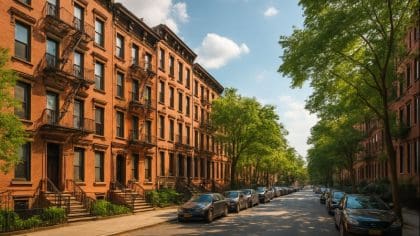Navigating the rental market in New York City can be daunting, especially when trying to find affordable housing. Rent-stabilized apartments offer a solution for many residents, providing more predictable rent increases and additional tenant protections. This guide dives into everything you need to know about rent-stabilized apartments in NYC, from eligibility criteria to tenant rights.
Quick Summary
Rent-stabilized apartments in NYC provide tenants with significant protections and more predictable rent increases. To qualify, the building must meet specific criteria, and some apartments may have additional income and rent limits. The Rent Guidelines Board regulates rent increases, ensuring housing affordability. Finding a rent-stabilized apartment can be challenging due to the high demand for a renter, but resources like online listings and networking can help. Tenants have extensive rights, including lease renewal and protection against unlawful eviction. Understanding maintenance responsibilities, subletting rules, and legal resources can further support tenants in these apartments.
Introduction to Rent Stabilized Apartments in NYC
Rent stabilization is a form of rent control regulation that applies to approximately one million apartments in New York City. These apartments are subject to guidelines that limit rent increases, providing tenants with more stability and affordability. Understanding rent stabilization can help you make informed decisions about your housing options in the city.
Eligibility Criteria for Rent Stabilization
What is Rent Stabilization?
Rent stabilization applies to buildings built before 1974 with six or more units, though newer buildings may also qualify if they receive certain tax benefits. To determine if an apartment is rent-stabilized, check the building’s construction date, the number of units, and any tax incentives it may have received.
Income and Rent Limits
Some rent-stabilized apartments have income and rent limits, particularly if they are part of affordable housing programs. Generally, if your household income is below a certain threshold and your rent does not exceed a specified amount, you may qualify for a rent-stabilized unit.
Understanding Rent Guidelines and Increases
How Rent Increases are Determined
Rent increases for stabilized apartments are regulated by the Rent Guidelines Board (RGB), which sets the maximum allowable rent increases each year for the whole housing market and increase market rate. These guidelines aim to balance the needs of tenants and landlords, ensuring affordability while allowing for property maintenance and improvements.
Lease Renewal Increases
When renewing a lease for a rent-stabilized apartment, the landlord can only increase the rent by the amount specified by the RGB. This provides tenants with predictability and protection against sudden, large rent hikes.
Finding Rent Stabilized Apartments in NYC
Where to Look
Finding a rent-stabilized apartment can be challenging due to high demand and limited availability. Use online resources like StreetEasy, Craigslist, and local real estate listings to identify potential rent-stabilized units. Additionally, contacting property management companies and brokers who specialize in rent-stabilized buildings can be helpful.
Tips for Securing a Rent Stabilized Apartment
- Act Quickly: These apartments are in high demand, so be prepared to act fast when you find a listing.
- Prepare Documentation: Have your financial documents, identification, and references ready to streamline the application process.
- Network: Sometimes, word-of-mouth referrals from friends, family, or coworkers can lead to discovering rent-stabilized units.
Rights and Protections for Rent Stabilized Tenants
Legal Protections
Rent-stabilized tenants have significant legal protections, including the right to renew their lease and protection against unlawful eviction. The landlord must provide a written lease renewal offer 90 to 150 days before the current lease expires.
Overcharge Complaints
If you believe your landlord is charging more than the legal rent, you can file an overcharge complaint with the New York State Division of Housing and Community Renewal (DHCR). This process ensures that tenants are not being unfairly charged.
Renewing a Rent Stabilized Lease
Renewal Process
The landlord must offer you a lease renewal between 90 and 150 days before your current lease expires. You have 60 days to accept the offer. The new lease must comply with RGB guidelines for rent increases.
Lease Terms
The renewal lease must be for a one- or two-year term, depending on the tenant’s choice. The rent increase will be based on the rates set by the RGB for the chosen term length.
Maintenance and Repairs in Rent Stabilized Apartments
Landlord Responsibilities
Landlords of rent-stabilized apartments must maintain the property in good repair and ensure that all essential services, such as heat and hot water, are provided. If the landlord fails to make necessary repairs, tenants can file a complaint with DHCR.
Tenant Responsibilities
Tenants are responsible for keeping their apartment clean and undamaged. Reporting maintenance issues promptly and following proper procedures can help ensure that repairs are made in a timely manner.
Subletting and Transferring a Rent Stabilized Lease
Subletting Rules
Tenants in rent-stabilized apartments have the right to sublet their unit with the landlord’s permission. However, there are specific rules and procedures that must be followed, including providing the landlord with a written request and obtaining their approval.
Transferring a Lease
Under certain circumstances, you may transfer your lease to another person. This process, known as lease assignment, typically requires the landlord’s consent and adherence to specific legal requirements.
Dispute Resolution and Legal Rights for Tenants
Resolving Disputes
Disputes between tenants and landlords can arise over a variety of issues, such as rent increases, maintenance, and lease terms. Resolving these disputes often begins with direct negotiation and communication.
Here are some steps to consider when facing a dispute:
- Document Everything: Keep detailed records of all interactions with your landlord, including emails, letters, and notes from phone calls or in-person meetings. Document any maintenance issues with photos or videos.
- Review Your Lease: Understand the terms of your lease agreement, as it will outline the rights and responsibilities of both you and your landlord. This can provide a foundation for resolving disputes.
- Communicate Clearly: Clearly communicate your concerns to your landlord in writing. Be specific about the issues you’re facing and what resolution you are seeking.
- Seek Mediation: If direct communication fails, consider seeking mediation. Mediation is a voluntary process where an impartial third party helps both parties reach a mutually agreeable solution.
- Contact Tenant Associations: Tenant associations can offer support and advice on dealing with disputes. They can provide insights based on similar experiences of other tenants.
If these steps do not resolve the issue, tenants have the right to seek assistance from government agencies or the housing crisis court.
Legal Aid and Resources
If negotiations and mediation do not resolve the dispute, tenants can turn to legal aid and other resources. Several organizations provide legal assistance to tenants, helping them understand their rights and navigate the legal system.
These resources can offer invaluable support:
- Legal Aid Society: The Legal Aid Society provides free legal services to low-income tenants facing eviction or other housing-related issues. They offer representation in housing court and can help tenants understand their legal rights.
- Housing Court Answers: This organization provides information on housing court procedures and tenant protection rights. They offer guidance on how to prepare for court, what to expect during proceedings, and how to file necessary paperwork.
- Metropolitan Council on Housing: This tenant advocacy group offers advice and support for tenants in rent-stabilized apartments. They provide resources on tenants’ rights, rent regulations, and how to handle disputes with landlords.
Resources for Further Assistance and Information
For additional support and information, tenants can turn to various government agencies and tenant advocacy groups. These organizations provide comprehensive resources on rent stabilization laws, tenant rights, and the processes for filing complaints and resolving disputes.
Government Agencies
- New York State Division of Housing and Community Renewal (DHCR): The DHCR oversees rent stabilization laws and provides information on tenant rights and landlord obligations. Tenants can file complaints with DHCR regarding rent overcharges, maintenance issues, and other disputes.
- New York City Rent Guidelines Board (RGB): The RGB sets annual rent increase rates for rent-stabilized apartments. They provide resources on how these rates are determined and what tenants can expect in terms of rent increases.
Tenant Advocacy Groups
- Metropolitan Council on Housing: This group offers advice and support for tenants in rent-stabilized apartments. They provide resources on tenants’ rights, how to handle disputes with landlords, and information on rent regulations.
- Housing Court Answers: This organization provides information on housing court procedures and tenant rights. They help tenants prepare for court, understand the legal process, and provide guidance on how to file complaints and motions.
By utilizing these resources, tenants can better understand their rights and find the necessary support to resolve disputes and navigate the complexities of living in rent-stabilized apartments.





